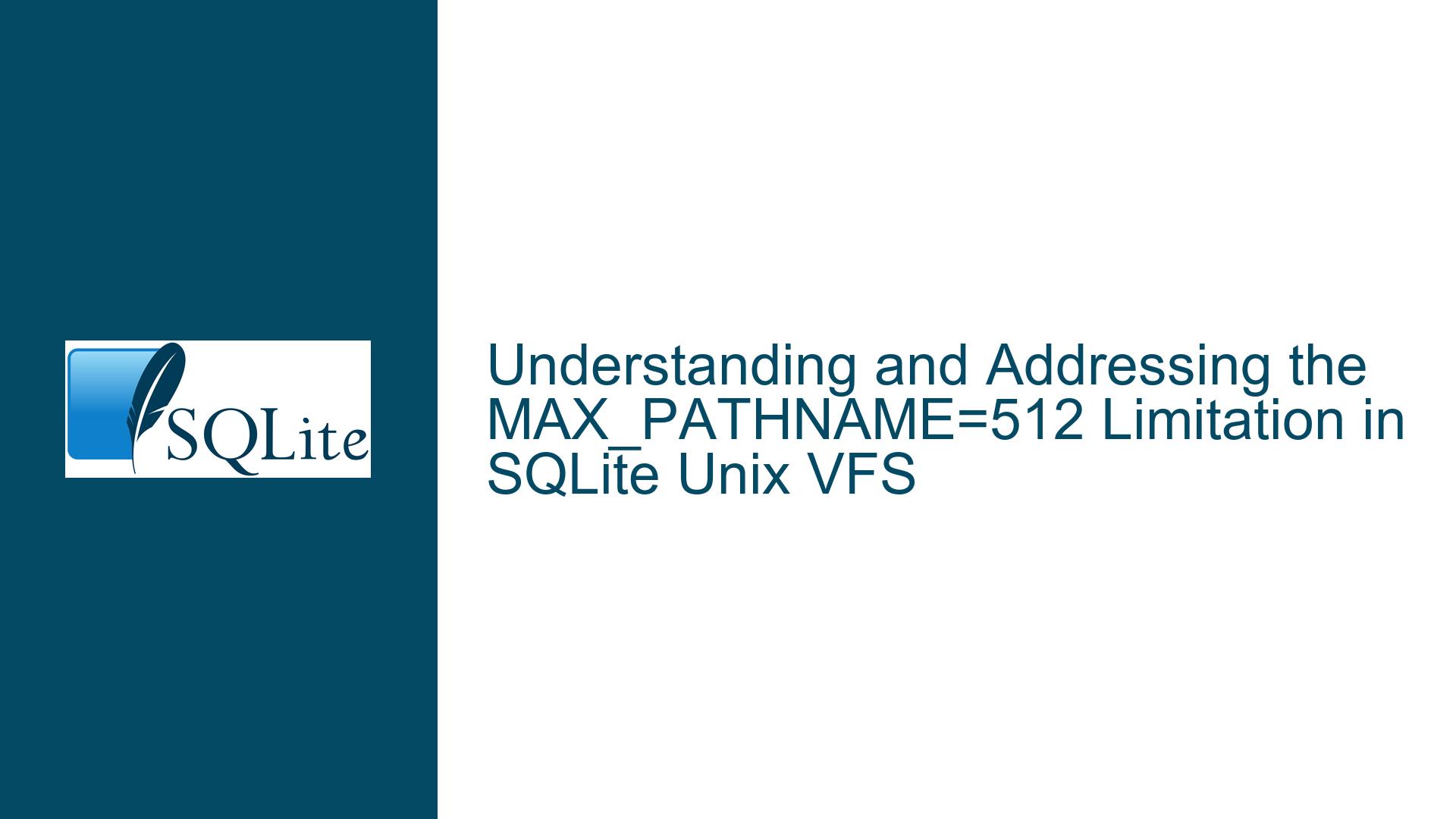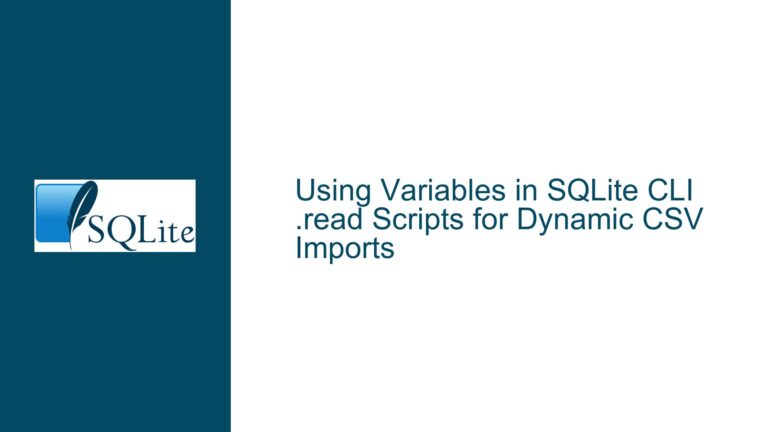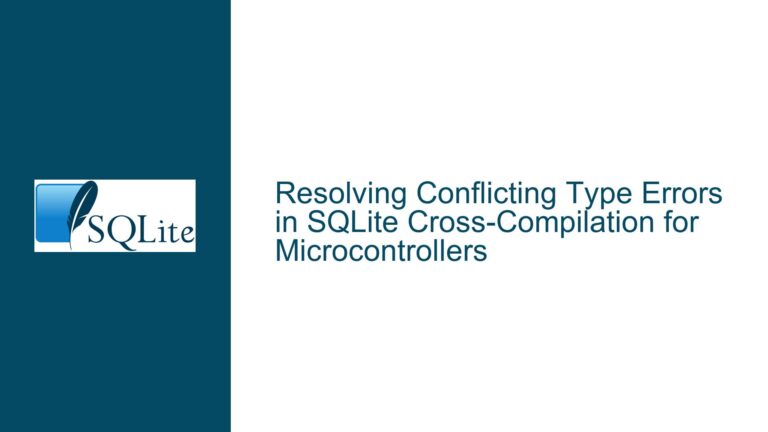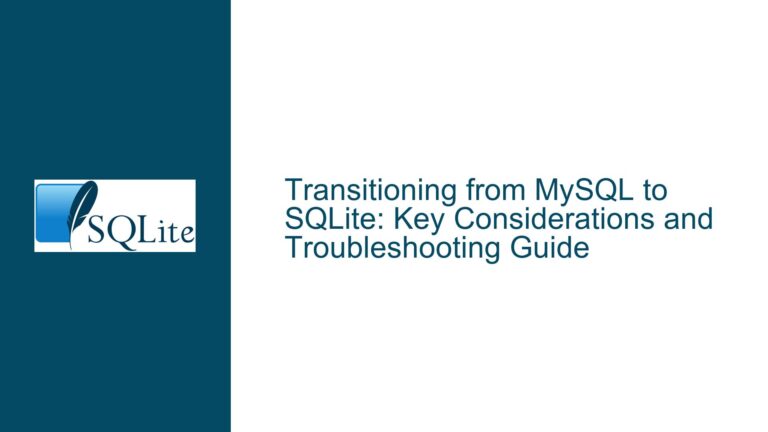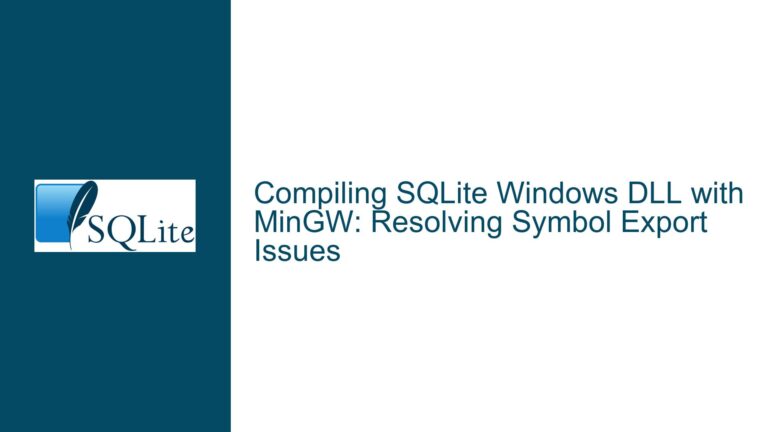and Addressing the MAX_PATHNAME=512 Limitation in SQLite Unix VFS
The MAX_PATHNAME=512 Limitation in SQLite Unix VFS
SQLite, a widely-used embedded database engine, employs a Virtual File System (VFS) abstraction layer to interact with the underlying operating system’s file system. This abstraction allows SQLite to be portable across various platforms, including Unix-like systems. However, one notable limitation in SQLite’s Unix VFS implementation is the hard-coded maximum pathname length of 512 bytes, defined as MAX_PATHNAME in the os_unix.c source file. This limitation has raised questions among developers, particularly those working on modern Linux systems where the maximum pathname length can be as large as 4096 bytes. This post delves into the reasons behind this limitation, explores the potential causes, and provides detailed troubleshooting steps and solutions for those affected by this constraint.
The Historical and Technical Rationale Behind MAX_PATHNAME=512
The MAX_PATHNAME=512 limitation in SQLite’s Unix VFS is rooted in historical and technical considerations. When SQLite was initially developed, the Unix-like operating systems of the time often had a maximum pathname length of 512 bytes. This value was chosen as a conservative estimate to ensure compatibility across a wide range of systems, including those with more restrictive limits. The decision to hard-code this value was also influenced by the challenges associated with dynamically determining the maximum pathname length at runtime.
In Unix-like systems, the maximum pathname length can vary depending on the specific file system in use, the presence of network file systems (NFS), and the configuration of chroot or container environments. For example, the pathconf("…", _PC_PATH_MAX) function, which is used to query the maximum pathname length for a given path, was not universally available or portable across all Unix-like systems when SQLite was first developed. Even today, while most modern systems support this function, there are still edge cases where the maximum pathname length cannot be determined reliably at compile time.
Furthermore, the choice of 512 bytes as the maximum pathname length reflects a balance between compatibility and performance. A smaller maximum pathname length reduces the memory footprint of the VFS layer and simplifies the implementation, which is particularly important for an embedded database engine designed to be lightweight and efficient. However, this decision has become a point of contention as modern systems have evolved to support much longer pathnames, and developers increasingly encounter scenarios where the 512-byte limit is restrictive.
Potential Causes of the MAX_PATHNAME=512 Limitation
The MAX_PATHNAME=512 limitation in SQLite’s Unix VFS can be attributed to several factors, including historical compatibility, portability concerns, and the challenges associated with dynamic pathname length determination. One of the primary reasons for this limitation is the need to maintain compatibility with older Unix-like systems that may not support longer pathnames. By hard-coding the maximum pathname length to 512 bytes, SQLite ensures that it can run on a wide range of systems without requiring complex runtime checks or conditional compilation.
Another factor contributing to this limitation is the lack of a portable and reliable method for determining the maximum pathname length at compile time. While modern Unix-like systems provide the pathconf("…", _PC_PATH_MAX) function to query the maximum pathname length for a given path, this function is not available on all systems, and its behavior can vary depending on the specific file system and environment. For example, the maximum pathname length may differ between local file systems and network file systems, or between a host system and a chroot or container environment. This variability makes it difficult to establish a single, universally applicable maximum pathname length that can be determined at compile time.
Additionally, the choice of 512 bytes as the maximum pathname length reflects a trade-off between compatibility and performance. A smaller maximum pathname length reduces the memory footprint of the VFS layer and simplifies the implementation, which is particularly important for an embedded database engine designed to be lightweight and efficient. However, this decision has become a point of contention as modern systems have evolved to support much longer pathnames, and developers increasingly encounter scenarios where the 512-byte limit is restrictive.
Troubleshooting Steps, Solutions, and Fixes for the MAX_PATHNAME=512 Limitation
For developers encountering issues related to the MAX_PATHNAME=512 limitation in SQLite’s Unix VFS, there are several potential solutions and workarounds. The most straightforward approach is to modify the SQLite source code to increase the MAX_PATHNAME value and recompile the library. This approach is relatively simple but requires access to the SQLite source code and the ability to rebuild the library. Developers should be aware that increasing the MAX_PATHNAME value may have implications for memory usage and performance, particularly on systems with limited resources.
Another approach is to implement a custom VFS that supports longer pathnames. SQLite’s VFS abstraction layer allows developers to create custom implementations that can override the default behavior. By creating a custom VFS, developers can implement their own logic for handling pathnames, including support for longer pathnames. This approach provides greater flexibility but requires a deeper understanding of SQLite’s VFS interface and the underlying file system.
For developers who prefer not to modify the SQLite source code or implement a custom VFS, there are several workarounds that can be used to avoid exceeding the MAX_PATHNAME limit. One common workaround is to use symbolic links to shorten the pathnames used by SQLite. By creating symbolic links to directories with shorter pathnames, developers can effectively reduce the length of the pathnames used by SQLite without modifying the underlying file system structure. This approach is particularly useful in scenarios where the file system hierarchy is deep and complex.
Another workaround is to use relative pathnames instead of absolute pathnames. Relative pathnames are typically shorter than absolute pathnames and can help avoid exceeding the MAX_PATHNAME limit. However, this approach requires careful management of the current working directory and may not be suitable for all use cases.
In addition to these workarounds, developers can also consider using a different database engine that does not have the same pathname length limitations. While SQLite is a popular choice for embedded databases, there are other lightweight database engines that may be better suited to specific use cases. For example, some database engines are designed specifically for use with modern file systems and may offer better support for longer pathnames.
Finally, developers can advocate for changes to the SQLite codebase to make the MAX_PATHNAME value configurable. By submitting feature requests or patches to the SQLite development team, developers can help drive the evolution of the library to better meet the needs of modern systems. While this approach may take time, it has the potential to benefit the entire SQLite community by providing a more flexible and adaptable solution to the MAX_PATHNAME limitation.
In conclusion, the MAX_PATHNAME=512 limitation in SQLite’s Unix VFS is a historical artifact that reflects the challenges of maintaining compatibility and portability across a wide range of systems. While this limitation can be restrictive in modern environments, there are several potential solutions and workarounds available to developers. By understanding the underlying causes of this limitation and exploring the available options, developers can effectively address the challenges posed by the MAX_PATHNAME limit and continue to leverage the power and flexibility of SQLite in their applications.
